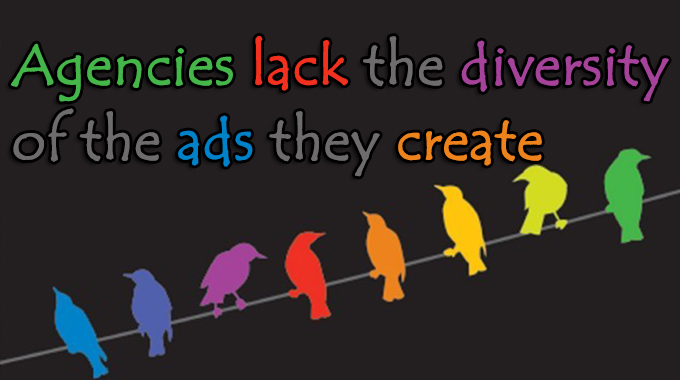Agencies lack the diversity of the ads they create

New research from BabyCenter shows that consumers love diversity in advertising. But there isn’t much of it behind-the-scenes, which came up during a recent SXSW panel.
The composition of the American family is changing. There are more interracial families, single mothers and fathers, and same-sex parents than ever before. And people want to see that reflected in advertising.
Recent research from BabyCenter and YouGov found that 80 percent of parents feel more positively toward brands that showcase a variety of families in their marketing. When it comes to making a purchase, 72 percent of respondents consider an alignment of the brand’s values with their own.
Additionally, 41 percent said they’d be more inclined to purchase something from one of those brands. And 70 percent have consciously not bought something because they didn’t believe in what the company stands for.
“[The numbers] were surprising because they’re so high, but it’s really encouraging how parents want to see real diversity represented in advertising today,” says Julie Michaelson, head of global sales at BabyCenter, who added that depicting more modern families in marketing is a good business move. “Because people talk about brands, brands have a really powerful role in encouraging inclusivity and building tolerance. If they present a diverse family as normal instead of different, that’s going to go a long way in society, I believe.”
The diversity discrepancy
BabyCenter’s report came up during a South By Southwest panel entitled, “The Scariest Word in Brand Advertising: Family.” Vida Cornelious, a panelist and chief creative officer at Walton Isaacson, also discussed the discrepancy of diversity in ads and the agencies that create them, particularly within senior leadership.
“It’s a case of unconscious – or conscious – bias, plain and simple. I’m sure some people feel it’s easier to work with, hire, mentor, spend time with, disagree with, and collaborate with people who look like themselves,” says Cornelious. “I think it has become a generational, institutional problem. I believe many people who have worked inside large agencies, myself included, are not surprised when they’re forced to be a ‘lone wolf,’ being the only person of color.”
Every month, ClickZ does a “Digital People on the Move” feature about senior-level appointments within the industry. In an unscientific-but-telling experiment, I looked at all the round-ups from the first three pages of Google results for “People on the Move+ClickZ.” Of 132 digital people on the move, 73 (55 percent) are white men and 32 (24 percent) are white women. The majority of the remaining 27 people are predominantly Asian men; only two are black and four are women.
According to Cornelious, this is ultimately problematic for brands. If agencies aren’t multicultural themselves, the ads they create run the risk coming off as one-dimensional or even stereotypical.
“Perspective is everything to storytelling. You have to be able to understand or empathize with the perspective of your audience in order to truly connect with it,” says Cornelious. “Having more diverse individuals in the industry means more opportunity for stories to be crafted from the ‘inside out,’ meaning, created by individuals that can truly relate and tell that story truthfully.”
The diversity development
If those stories are told, but don’t come off as authentic, that can hurt a brand more than multicultural marketing can help it. Tweeting a hashtag like #LoveWins comes off as pandering, if your actions don’t support it. For example, a few years back, Target caught flack for supporting both the Twin Cities Pride Festival and Tom Emmer, a conservative Minnesota politician who has spoken out against same-sex marriage.
“I think people want to move forward and showing diversity naturally brings us together. When we’re together, we’re stronger – I think people believe that, as a universal value,” says Nelson Freitas, chief strategy officer at Wunderman New York. “[For brands], I think visualization is just one element. It’ll come across as if you’re trying too hard if your message doesn’t somehow support your look.”
Target has since apologized while continuing to support the LGBT community, with ads featuring gay dads and gender-neutral signage. However, the public isn’t always so quick to forgive. Exclusionary remarks from the former CEO of Abercrombie & Fitch went viral in 2013. The retailer’s sales were already on the decline and those comments didn’t help.
The BabyCenter report was full of takeaways for those looking to market more diverse messages. How can the industry follow its own advice?
Though groups like Interactive Advertising Bureau (IAB) and the American Association of Advertising Agencies (4A’s) have launched diversity initiatives, agencies remains pretty homogeneous. In Cornelious’ opinion, changing that starts at the top.
“It’s important that there are more diverse individuals in positions of power in media, in Hollywood, in boardrooms, and in ad agencies because those are the places where images of diverse people are being shaped for the media. The repercussions of getting it wrong far outweigh not having the right people on your team to get it right,” she says. “There needs to be commitment from Madison Avenue to add diverse leaders to their ranks, not just entry-level talent and interns to make a quota.”
___
by Mike O’Brien

